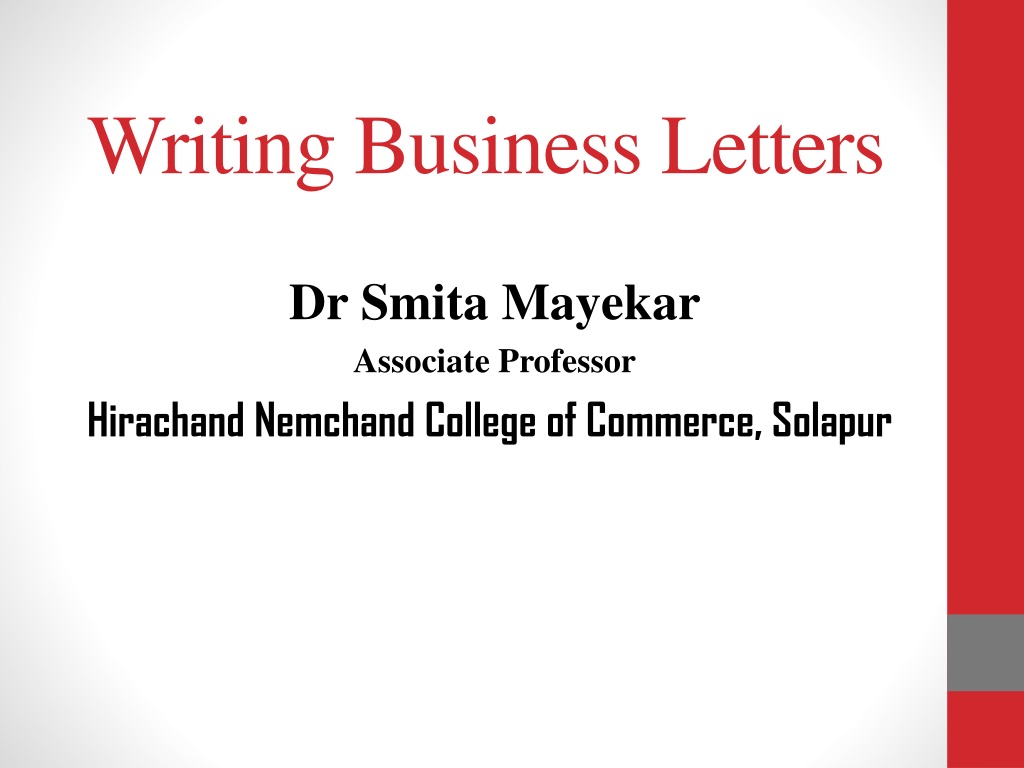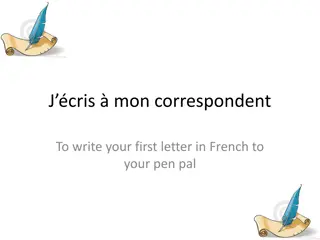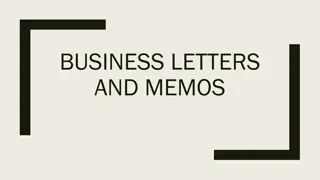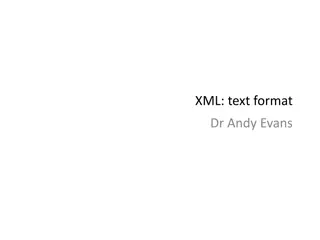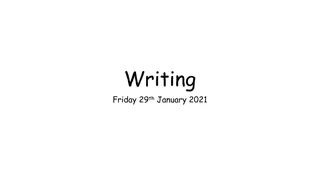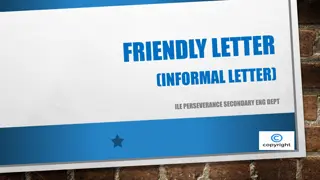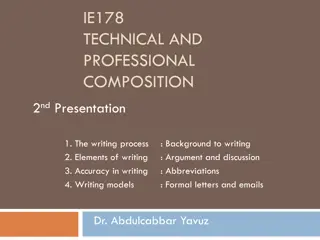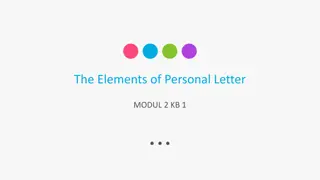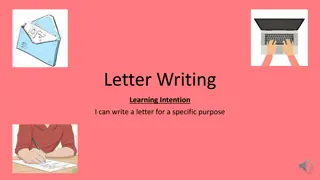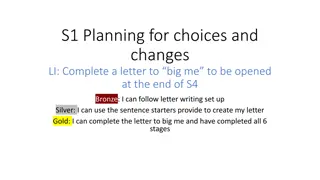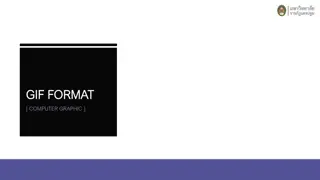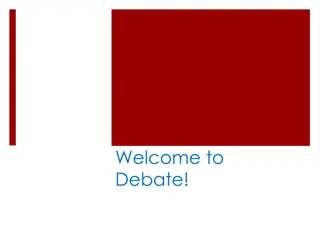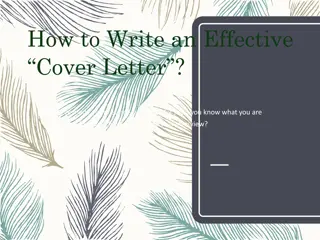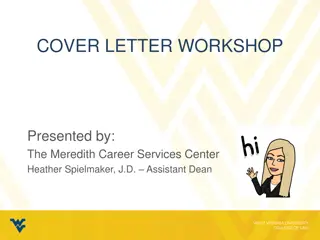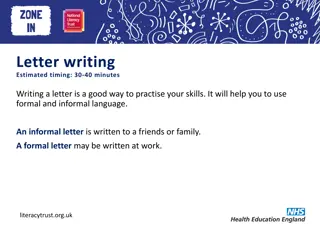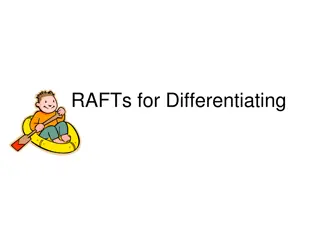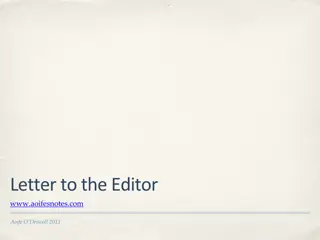Business Letter Writing Guidelines and Formats
Learn about the essential parts of a business letter, including the heading, addressee, subject, salutation, body paragraphs, complimentary close, and signature. Understand various formats/styles such as block, modified block, and semi-block. Discover sample formats and guidelines for writing effective business letters using the 7 Cs of communication.
Download Presentation

Please find below an Image/Link to download the presentation.
The content on the website is provided AS IS for your information and personal use only. It may not be sold, licensed, or shared on other websites without obtaining consent from the author. Download presentation by click this link. If you encounter any issues during the download, it is possible that the publisher has removed the file from their server.
E N D
Presentation Transcript
Writing Business Letters Dr Smita Mayekar Associate Professor Hirachand Nemchand College of Commerce, Solapur
Contents Parts of a Letter Formats/ Styles of a Business Letter Sample Formats Guidelines for writing an Effective Business Letter(7 Cs)
Parts of a Business Letter Heading Letter head address Most companies use letterhead--stationery with the company s logo, name, address and other contact details If the company does not have letterhead, the company s full name and address should be typed at the top of the page in accordance to the format used. Date line Never write the date using all numerals. Use the month name spelled out, then the day, followed by year in the four-digit year, for example, June 6, 2010. Reference Include a reference line to identify a file or case number, invoice number or any other internal identifying information, if your company requires one.
Cont. Addressee Inside address Your letter should include the name of the addressee / receiver , designation, company name and full address, including the postal code. Subject Normally the subject sentence follows the word Subject: or Re: (regarding). Salutation Most salutations in Business Letters begin with Dear followed by either the recipient s first name, or title and last name. However, if you don t know the person s name, use Dear Madam/ Sir, or the job title, such as Dear Accounting Manager.
Cont Body Paragraphs The opening paragraph should always state why you are writing. Then explain the situation, the solution, the suggestion or whatever other message you need to get across to the recipient. Start a new paragraph whenever you begin a new subject. Complimentary Close complimentary closure It is a short, polite closing followed by a comma. When the letter is impersonal, use Yours truly. If the letter is to someone above you in rank, use Respectfully yours. If you have a personal connection to the addressee, use Sincerely or Sincerely yours Signature Four spaces below the close, type your full or business name. In the space in- between, you will hand write your signature in ink. Use black or dark blue ink for your signature. Notation: . Add the notations like enc, cc if required
Formats/Styles of Business Letter Block Format Modified Block Semi Block
Completeness and Consideration The message must be complete. It should convey all the facts required by the audience. The sender of the message must take into consideration the receiver and should communicate all the facts and figures related to the message.
Conciseness Conciseness means communicating what you want to convey in least possible words. Conciseness is a necessity for effective communication. Concise communication has following features: It is both time-saving as well as cost-saving. It underlines and highlights the main message. Concise communication provides short and essential message in limited words to the audience. Concise message is more appealing and comprehensible to the audience.
Consideration Consideration implies stepping into the shoes of others . Effective communication must take the audience into consideration, i.e, the audience s view points, background, mind-set, education level, etc. Make an attempt to envisage your audience, their requirements, emotions as well as problems. Ensure that the self-respect of the audience is maintained and their emotions are not at harm.
Clarity Clarity implies emphasizing on a specific message or goal at a time, rather than trying to achieve too much at once. Clarity in communication has following features: It makes understanding easier. Complete clarity of thoughts and ideas enhances the meaning of message. Clear message makes use of exact, appropriate and concrete words
Concreteness Concrete communication implies being particular and clear rather than fuzzy and general. Concreteness strengthens the confidence. Concrete message has following features: It is supported with specific facts and figures. It makes use of words that are clear and that build the reputation.
Courtesy Courtesy in message implies the message should show the sender s expression as well as should respect the receiver. The sender of the message should be sincerely polite, judicious, reflective and enthusiastic. Courteous message has following features: Courtesy implies taking into consideration both viewpoints as well as feelings of the receiver of the message. Courteous message is positive and focused at the audience. It makes use of terms showing respect for the receiver of message. It is not at all biased
Correctness Correctness in communication implies that there are no grammatical errors in communication. Correct communication has following features: The message is exact, correct and well-timed. If the communication is correct, it boosts up the confidence level. Correct message has greater impact on the audience/ readers. It checks for the precision and accurateness of facts and figures used in the message. It makes use of appropriate and correct language in the message.
Dos and Donts Do take the time to find out the hiring manager's name, and open the letter with a proper greeting Do use simple language and uncomplicated sentence structure. Eliminate all unnecessary words. Do proofread the letter repeatedly Do keep your letter brief but complete Don t send a letter that contains any typos, misspellings, incorrect grammar or punctuation, smudges, or grease. Don t forget to personally sign the letter, preferably in blueink.
Conclusion As it comes under formal letters, the words and phrases should be carefully chosen. The language should be simple and easy to understand. The content of the letter should be short and straightforward . Appropriate format should be used.
